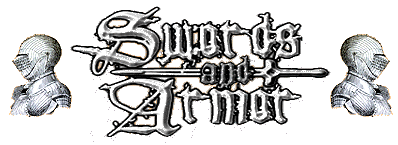

Decorative Display Breastplates Directly Below
Etched AB2151
European History and its effect on Medieval Armor
The Medieval period lasted
around 1000 years with historians placing the beginning around 500 AD and the
end around 1500 AD. The thousand years prior to this time were no easier for
Europe with the Celtic domination of all of Europe and the British Isles, the
Norsemen beginning to spread across the Northern areas and the rise and fall of
the Roman Empire as it battled its way across the terrains of Europe, Asia and
Africa.
Europe became a very chaotic and ungoverned land by 500 AD,
suffering turmoil with Germanic tribal warfare, remnants of classical
civilizations slowly winding down, Norsemen swarming the British Isles and parts
of Northern Europe while Asiatic Hordes were wiping up the last remnants of
Greek and Roman civilization in the Eastern regions. All of this fighting and
clash of various cultures produced a wide array of armor and weaponry that was
used, and interchanged by all the groups involved, with little regard for a
certain style that was supposed to be worn by the common soldier.
The breastplate evolved from the Bronze Age through the
Greek and Roman cultures and bronze was the first metal used but found to be too
soft to protect its owner as well as iron. When iron was discovered, great
advances were made in the coverings for soldiers but it was the use of steel
that finally brought us the breastplates of the Medieval Ages that remain in our
imagination from the knights of old. The Celts and the Germanic or Teutonic
tribes favored a lighter armor, usually covering their torsos with only a cloak
with woolen trousers (Celtic style) or nothing at all (Teutonic tribes favored
this). But as contact with Rome began, leather breastplates, which mimicked the
Roman breastplates, began to appear and the Celts developed the first chainmail
coverings that were quickly popular with their enemies, the Romans, and its use
spread throughout Europe into the many armies that fought there.
In the early period of 500-800 AD, Rome had lost all its
Western holdings and ownership of the territories it had taken from the Celts.
These holdings were by this time divided up between the last of the Celtic
nation, the Saxons and the Angles in Britain, the Germanic Franks and other
lesser Germanic tribes that were eventually absorbed into the Frankish culture
in Northwestern and Central Europe, the Norse in the far North and the remnants
of the Roman Empire with the Eastern Church mixing with the more distant
cultures integrated from the Asiatic or Eastern hordes in the southern regions.
It was also a time of great turmoil with the Black Plague being carried by rats
on trade ships and following the armies of Europe, bringing death by the
millions throughout the lands.
By 800 AD, order began to emerge and the next 700 years
showed more refinement in both the cultures and the governing of these troubled
areas. As this was more stabilized, armor and weapons became more uniform. The
golden age of knighthood was begun around 1100 AD with the conquest of England
by the leaders of Normandy, who had evolved from the Norse and Frankish kingdoms
of Northern Europe. Their conquest of England had as much to do with the fact
that English armor at the time was based on more leather, bronze and iron and
they had more steel and iron armor, as their leadership and England’s infighting
amongst its native tribes. The Germanic tribes were no better as there was
constant struggle between the ten kingdoms that formed most of the European
continent under the Holy Roman Emperor, which gave us Gothic armor stylized to
represent the various factions in that empire.
European armor is as varied as its history, with wave after
wave of conquerors with their own languages, cultures and styles of fighting.
Their armor varied from bronze to iron to steel and leather and their
breastplate coverings and helmets and their approach to battle tactics could
usually identify the combatants. But these ancient enemies learned from each
other, bringing home the spoils of war which their blacksmiths would study and
improve. The common soldier would pick through the battlefields to replace his
own ruined armor with the armor of the dead and sometimes this armor was passed
through many generations for use. It would not have been uncommon to see, not as
we see into day’s rank and file of uniformly dressed soldiers, but a hodgepodge
of different styles from different time periods throughout the ranks of every
battle weary legion, tribe and band of the Medieval Age soldier.
Contact Us Via Email Leather Armor Harness
Armor Home Wearable Armor Index
Swords and Armor
Specials !
New Introductions - Closeouts -
All Great Bargains
Shipping Policies and Rates - Returns
copyright © 2001-2014 swordsandarmor.com . All Rights Reserved
privacy policy